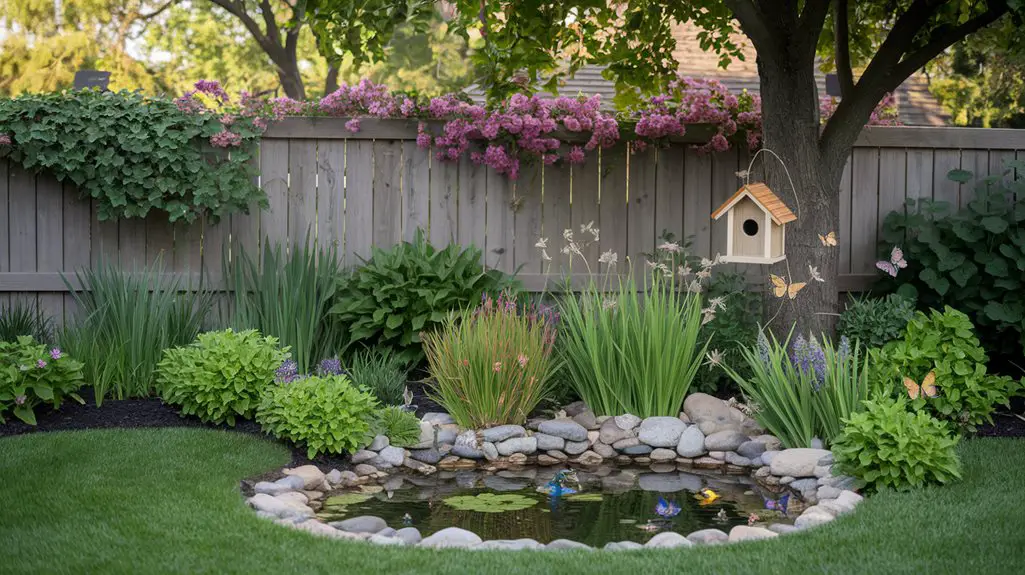Maintaining a vibrant backyard wildlife habitat requires your attention to several key practices. Consider how regular water source maintenance can greatly impact wildlife accessibility, or how adopting sustainable plant pruning techniques enhances growth without stressing vegetation. Don't forget to inspect nesting structures, ensuring they're safe for diverse species. By managing pests with eco-friendly methods and consistently monitoring soil health, you're fostering a thriving ecosystem. Are you ready to transform your backyard into a haven for diverse wildlife species?
Schedule Regular Water Source Maintenance
Maintaining your backyard wildlife habitat requires regular attention to water sources, as even the smallest neglect can affect local fauna.
Regularly check birdbaths, ponds, and water dishes to guarantee they're clean and filled. Algae buildup can deter animals and influence water quality, so scrub surfaces consistently. Use a natural filter in ponds to help balance the ecosystem, and regularly check for leaks or blockages.
Observe how rain affects your water sources; you might need to adjust positioning or drainage to prevent stagnation. Providing multiple water sources throughout your garden will enhance accessibility for different species.
Install a shallow dish filled with clean pebbles to allow smaller creatures like bees to safely hydrate. Additionally, incorporating native plants can improve the overall habitat and provide more natural food sources for wildlife. Proper upkeep encourages a thriving, balanced wildlife community.
Implement Sustainable Plant Pruning Techniques
Effective management of water sources goes hand in hand with implementing sustainable plant pruning techniques to foster a robust backyard wildlife habitat.
Pruning isn't just about aesthetics; it's a vital method to promote plant health and biodiversity. Research suggests you should prune selectively, focusing on dead, diseased, or overcrowded branches. This boosts plant vigor and provides wildlife with dense backgrounds for shelter.
Avoid over-pruning; excessive removal can stress plants, reducing their ecological benefits. Instead, use the "thinning cut" method, which removes entire branches, allowing light and air to penetrate while maintaining plant structure.
Additionally, timing is essential. Prune after plants have flowered or fruited to avoid disrupting food sources. These tactics help sustain a balanced and vibrant ecosystem. Moreover, incorporating natural pest control methods can further enhance the health of your plants and attract beneficial wildlife to your garden.
Regularly Inspect and Repair Nesting Structures
Although often overlooked, regular inspection and repair of nesting structures is essential for maintaining a thriving backyard wildlife habitat.
Begin by examining these structures seasonally, focusing on signs of wear, weather damage, or pest intrusion, as these factors can compromise the habitat's integrity. Research suggests that weakened or damaged nesting sites reduce nesting success rates and can deter species from returning to your yard. Additionally, incorporating native plants for wildlife into your habitat can enhance the overall appeal and functionality of nesting structures.
Use durable, weather-resistant materials for repairs and guarantee that all structures remain stable and adequately spaced to avoid territorial conflicts.
Replacing or reinforcing damaged parts prevents structural failures that could harm the wildlife you're aiming to protect.
Manage Pest Populations With Eco-Friendly Solutions
To effectively manage pest populations in your backyard wildlife habitat, consider employing eco-friendly solutions that align with sustainable practices.
Pests can disrupt the balance of your habitat, but there's no need to resort to harmful chemicals. Instead, explore natural methods that reduce pests while supporting environmental health:
- Introduce Beneficial Insects: Encourage ladybugs and lacewings, known for controlling aphid populations.
- Create Habitat for Birds: Birds are natural predators of many pests, so install birdhouses to attract them.
- Utilize Neem Oil: Apply neem oil as a natural insecticide effective against a variety of pests.
- Implement Companion Planting: Use specific plant combinations that repel pests or attract beneficial insects.
Additionally, consider using organic pest control methods to further enhance your pest management strategy.
Monitor and Improve Soil Health Consistently
Keeping a close eye on soil health is essential for maintaining a thriving backyard wildlife habitat. Start by conducting regular soil tests to evaluate pH levels, nutrient content, and organic matter.
These tests guide informed decisions on amendments like compost and fertilizers. Analyzing the results helps you address deficiencies without overwhelming the ecosystem.
Add organic matter, such as decomposed leaves, to improve soil texture and microbial activity. Healthy soil supports diverse plant life, which in turn attracts various wildlife species. Additionally, incorporating essential composting tips can enhance the nutrient profile of your soil and promote a healthier habitat.
Maintain a balance by rotating plant species and employing cover crops that enrich the soil during non-growing seasons. Also, guarantee proper drainage to prevent waterlogging and soil erosion.
Conclusion
Picture a serene backyard haven, where vibrant butterflies dance among flourishing blooms, and birds sing from sturdy, well-maintained nests. Each element thrives under your careful watch, reflecting a harmonious balance. By diligently maintaining clean water sources, selectively pruning plants, and implementing eco-friendly pest control, you'll cultivate a flourishing habitat. Regular soil checks guarantee the ground beneath supports a diverse array of life. Your consistent efforts transform mere space into a living, breathing ecosystem teeming with diverse wildlife.




